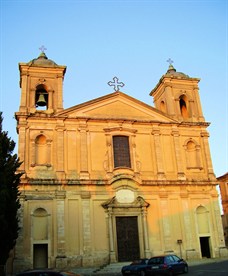Vibo Valentia
 A region on the periphery of a Kingdom on the periphery of the vast empire of the Habsburgs of Spain, Calabria had a politically marginal role at best in the early modern period. Burdened, as all the viceroyalty of Naples was, by the financial weight of Madrid, by costly military engagements, the region was subject to constant and heavy fiscal pressure and, in addition, the ample power of numerous aristocratic families often expressed itself in a violent and arbitrary way with respect to the populace. Calabria possessed fiefdoms of some of the most important noble families of the viceroyalty, such as the Sanseverino, the princes of Bisignano, the Ruffo, the dukes of Bagnara and princes of Scilla, the Carafa, the princes of Roccella, the Spinelli, the dukes of Seminara and princes of Cariati or the Pignatelli, the dukes of Monteleone. Alongside these families who could boast storied lineages, the power and influence of more recent noble families who had become wealthy in a short time increased (which allowed them to acquire land and aristocratic titles) and who often were originally not from those regions but were, in particular, from Genoa: for example the Grimaldi from Gerace, the Serra from Cassano, the Cigala from Tiriolo, the Saluzzo from Corigliano or the Ravaschieri from Satriano. Many cities, above all in the first half of the sixteenth century, were sold to the holders of fiefdoms to increase the coffers of the state. Some managed to buy back their own liberty, others openly rebelled and often in vain, to obtain their reincorporation into crown property. Oftentimes protected by powerful aristocrats, if not directly paid by them, the brigands constituted yet another source of worry for the populace and one of the chronic ills which afflicted Calabria, ills which did not even disappear under Austrian nomination (1707-1734) nor under the Bourbon dynasty.
A region on the periphery of a Kingdom on the periphery of the vast empire of the Habsburgs of Spain, Calabria had a politically marginal role at best in the early modern period. Burdened, as all the viceroyalty of Naples was, by the financial weight of Madrid, by costly military engagements, the region was subject to constant and heavy fiscal pressure and, in addition, the ample power of numerous aristocratic families often expressed itself in a violent and arbitrary way with respect to the populace. Calabria possessed fiefdoms of some of the most important noble families of the viceroyalty, such as the Sanseverino, the princes of Bisignano, the Ruffo, the dukes of Bagnara and princes of Scilla, the Carafa, the princes of Roccella, the Spinelli, the dukes of Seminara and princes of Cariati or the Pignatelli, the dukes of Monteleone. Alongside these families who could boast storied lineages, the power and influence of more recent noble families who had become wealthy in a short time increased (which allowed them to acquire land and aristocratic titles) and who often were originally not from those regions but were, in particular, from Genoa: for example the Grimaldi from Gerace, the Serra from Cassano, the Cigala from Tiriolo, the Saluzzo from Corigliano or the Ravaschieri from Satriano. Many cities, above all in the first half of the sixteenth century, were sold to the holders of fiefdoms to increase the coffers of the state. Some managed to buy back their own liberty, others openly rebelled and often in vain, to obtain their reincorporation into crown property. Oftentimes protected by powerful aristocrats, if not directly paid by them, the brigands constituted yet another source of worry for the populace and one of the chronic ills which afflicted Calabria, ills which did not even disappear under Austrian nomination (1707-1734) nor under the Bourbon dynasty.
Vibo Valentia, the former Monteleone, lost its status as a crown property at the beginning of the sixteenth century and was acquired by Ettore Pignatelli, lieutenant of the Camera della SommariaThe Regia Camera della Sommaria (The Royal Chamber of the Sommaria) was instituted by Alfonso V of Aragon, the Magnanimous (1394-1458). It was at once the royal auditor, a unified court of first instance in cases regarding fiscal issues and in second instance for sentences which were regarding the customs offices of Foggia and Abruzzo. It was replaced by the Regia Corte dei Conti (The Royal Court of Auditors) in 1807. (Chamber of the Sommaria) remaining under the control of his family, with the accompanying ducal title, until the suppression of the feudal regime. A centre of agricultural and wax production, many new buildings were built in Monteleone in the seventeenth century such as the convents of the Jesuits, the Carmelites and other Religious Orders. The collegiate church of San Leoluca, the cathedral of the city (photo), was built between 1680 and 1723 in the place where a Medieval church existed at the time of the earthquake of 1638.
